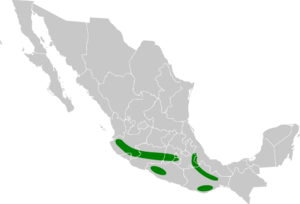Long-tailed wood partridge facts for kids
Quick facts for kids Long-tailed wood partridge |
|
|---|---|
| Conservation status | |
| Scientific classification | |
| Genus: |
Dendrortyx
|
| Species: |
macroura
|
 |
|
The long-tailed wood partridge (its scientific name is Dendrortyx macroura) is a type of bird. It belongs to the Odontophoridae family, which are also called New World quail. This special bird is only found in Mexico.
Contents
About the Long-Tailed Wood Partridge
The long-tailed wood partridge is a medium-sized bird. It can be about 29 to 42 centimeters (11 to 17 inches) long. It weighs between 266 and 465 grams (9 to 16 ounces). Male birds are usually a bit heavier than females. Both males and females have a long tail, but the female's tail is a little shorter.
Most of the bird's head is black. It has white stripes above and below its eyes. There is a short crest, or tuft of feathers, on top of its head. This crest has a buff, or light brownish-yellow, tip. The upper part of its back is a reddish-brown color with gray edges. The lower back is olive brown with black and tawny (orange-brown) spots. Its chest is bluish-gray with reddish-brown stripes. Young birds look similar but have dark brown spots and less reddish-brown on their undersides.
Where These Birds Live
The long-tailed wood partridge lives in different parts of Mexico. They are found in four main areas. These areas include the states of México, Veracruz, Jalisco, Michoacán, Guerrero, and Oaxaca.
These birds like to live in humid forests. They can be found in forests with pine, oak, fir, and other evergreen trees. They prefer places where there are many dense bushes and plants close to the ground. You can find them at high elevations, from about 1,200 to 3,300 meters (3,900 to 10,800 feet) above sea level.
How They Live and Behave
What They Eat
The long-tailed wood partridge mostly looks for food on the ground. They scratch through fallen leaves to find their meals. They also climb onto low branches to search for food. Their diet mainly includes seeds and small fruits. They also eat small insects and leaves.
Reproduction and Nests
The breeding season for the long-tailed wood partridge is from February to September. They start building their nests in late April. Scientists have found and described four of their nests.
One nest was a small dip in the ground. It was lined with grass inside a natural hollow. Another nest was a hollow filled with pine needles at the bottom of a rock. The other two nests were also found at the base of a rock or under a small bush. These last two nests were not very hidden. Three of the nests each had four eggs. The fourth nest had six eggs.
Bird Calls and Songs
The song of the long-tailed wood partridge is loud and has a strong rhythm. It is often sung as a duet by a pair of birds. One way to describe their song is "a loud, ringing korr-EEE-oh, korr-EEE-oh."
Pairs of these birds sing at any time of day or night during their breeding season. When it's not breeding season, they mostly sing at dawn and dusk from where they sleep at night. They also have an alarm call. This call is a series of short, low-pitched, squeaky sounds.
Conservation Status
The IUCN (International Union for Conservation of Nature) has listed the long-tailed wood partridge as a species of "Least Concern." This means they are not currently in danger of disappearing. However, their biggest threat is the loss of their natural home. This happens when people change the land for other uses.



